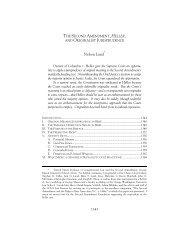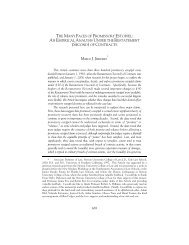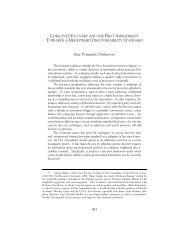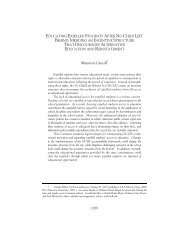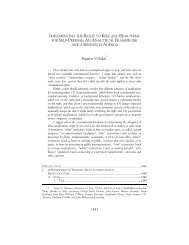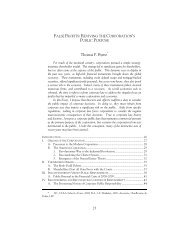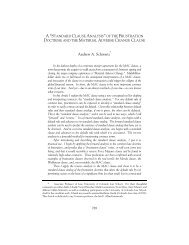Sonia K. Katyal - UCLA Law Review
Sonia K. Katyal - UCLA Law Review
Sonia K. Katyal - UCLA Law Review
Create successful ePaper yourself
Turn your PDF publications into a flip-book with our unique Google optimized e-Paper software.
1616 57 <strong>UCLA</strong> LAW REVIEW 1601 (2010)<br />
U.S. Supreme Court case of Friedman v. Rogers, 48 which involved a state statute<br />
that barred optometrists from practicing under a trade name, the Court found<br />
that trade names carried little or no informational content:<br />
Here, we are concerned with a form of commercial speech that has no<br />
intrinsic meaning. A trade name conveys no information about the price<br />
and nature of the services offered by the optometrist until it acquires<br />
meaning over a period of time by associations formed in the minds of the<br />
public between the name and some standard of price or quality. 49<br />
Following this view, scholars interpreted Friedman to suggest that<br />
trademarks have little expressive or informational value because they do<br />
not convey information intrinsically; it is only through secondary meaning<br />
that information becomes circulated, through “associations that grow up over<br />
time between the name and a certain level of price and quality of service.” 50<br />
The Friedman view initially facilitated a very limited scope of trademark<br />
protection, whereby courts initially saw a trademark as “little more than a vehicle<br />
through which consumers could match products with their producers.” 51<br />
The<br />
central justification for trademark law, under this view, is that it is a property<br />
right that functions, essentially, just like any other kind of private property in this<br />
context. Trademark protection thus protects the mark’s source-identifying<br />
function by ensuring that one party—the mark’s source—enjoys exclusive rights<br />
in a single context. Without such protection, the law reasons, both consumers<br />
and producers suffer. Consumers would face higher search costs in locating<br />
authentic goods, endangering the qualitative associations the consumer makes<br />
with a certain good, and ultimately making it less and less desirable for companies<br />
to engage in trademarking behavior. 52<br />
But there is a complexity that brands like AUNT JEMIMA plainly<br />
demonstrate. It is true that trademark law protects a brand’s proprietary, sourceidentifying<br />
function. 53<br />
But trademarks do more than lower consumer search<br />
48. 440 U.S. 1 (1979).<br />
49. Id. at 12.<br />
50. Id. at 16. For discussion of this point, see Jeffrey Lefstin, Note, Does the First Amendment Bar<br />
Cancellation of REDSKINS?, 52 STAN. L. REV. 665, 674–75 (2000).<br />
51. Mark P. McKenna, The Normative Foundations of Trademark <strong>Law</strong>, 82 NOTRE DAME L. REV.<br />
1839, 1843 (2007) (arguing that early trademark law was largely concerned with unfair competition, and<br />
was strongly influenced by natural rights theories of property); Dreyfuss, supra note 30 (reaching similar<br />
conclusions about trademark’s narrow functions).<br />
52. Trademark law protects against unauthorized proprietary uses in commerce, on the ground that<br />
classic forms of passing off (1) increase the costs of finding authentic goods in the marketplace; (2)<br />
misrepresent the quality and characteristics of the good; (3) fail to satisfy a customer who desires to<br />
purchase an authentic good; and (4) diminish the incentives to engage in further trademarking activity.<br />
See Barnes, supra note 34, at 23.<br />
53. See id. at 28.




